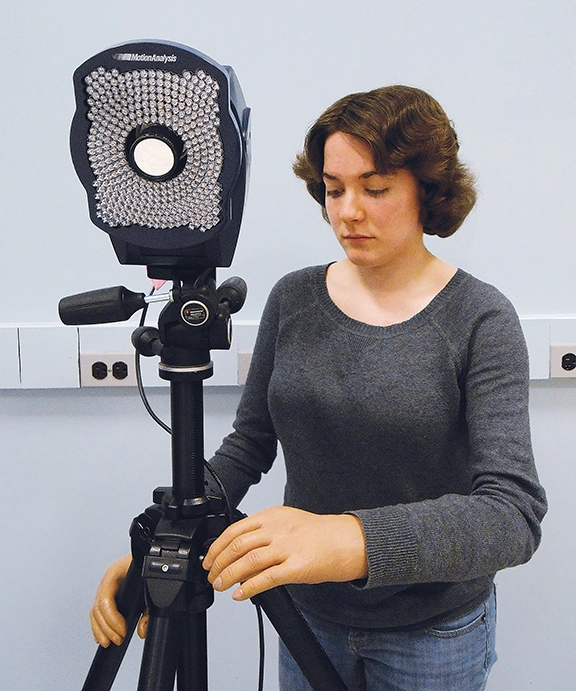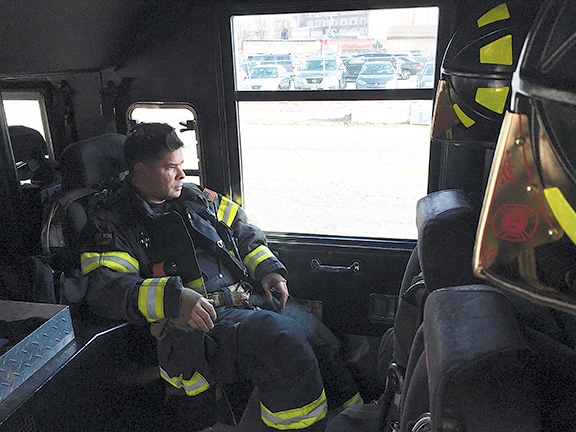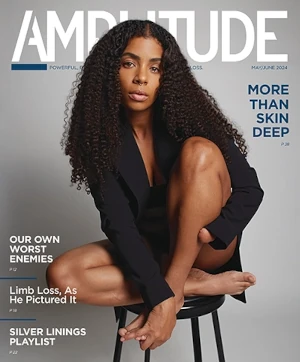By Élan Young
Three People With Limb Loss Share What Thriving Means to Them

The concept of thriving can be hard to understand, let alone measure, but it is commonly used to define how well a person has adjusted to a difficult circumstance.
External conditions tend to shape the narrative for how one succeeds or succumbs to life’s big challenges, and those living with limb loss are no exception. The medical community can point to many factors that influence how and why a person recovers, from age and physical condition prior to limb loss, to available support systems and recovery resources. What’s less clear is how a person’s overall outlook or attitude fits into the picture, although enough has been written about the subject to know that a positive outlook will more likely result in positive outcomes—or at least it can’t hurt. Amplitude shares with you the stories of three individuals who have learned how to use a positive attitude to help them thrive in the face of adversity.
The Free Spirit
Kanya Sesser has learned to thrive against all odds. The 23-year-old was born with no legs and was deposited on the steps of a Buddhist temple in her native Thailand when she was just a week old. There, she was raised by monks until she was 5, when an American couple from Portland, Oregon, adopted her, which she credits for giving her greater access to opportunities.
Despite not having legs, she grew up seemingly unaware of limitations, and her personal motto is “No legs, no limits.” Now a seasoned athlete, her focus is on maximum energy and maximum fun, whether she is sprinting, surfing, snowboarding, or playing wheelchair rugby. In addition to training for the 2018 Paralympics, she is a streetwear and lingerie model, as well as an occasional stunt performer for television.
With a free spirit that leads her from one opportunity to another, she is an example of how embracing one’s circumstances is an essential part of thriving.
“I think people in hard circumstances should make an effort to reach out and surround themselves with positive people,” she says. “This can go a long way to helping one improve their situation.”
Although she was not raised Buddhist by her adoptive parents, she credits the monks for instilling Buddhist wisdom that taught her how to value herself and be open to opportunities that life presents. It’s something she’s carried with her in all aspects of her life. And it seems that the more she succeeds in having fun, the more she is able to inspire others, which in turn brings additional opportunities her way.
Now she lives in California, where she might be surfing one day, modeling the next. Choosing a skateboard as her personal transportation device goes with her carefree image and outlook in life. Her Instagram profile (www.instagram.com/kanyasesser), which boasts more than 27 thousand followers, is also full of positive images of her enjoying life and sharing words of wisdom with the world. At every turn, this rising star is bent on making an impact by showing the world how she defines thriving.
The Student
Susannah Engdahl is another young woman with a personal story that has far-reaching implications. Now a 24-year-old doctoral student at the University of Michigan studying biomedical engineering, she was born missing both hands at the wrist and most of both feet. She acquired her first prosthesis at age 2 and her second at age 3. Since then, she’s gotten new prostheses every four to five years, and she wears orthotic inserts for extra foot support.

biomedical engineering.
Even though Engdahl and her family didn’t know any other kids with limb loss when she was growing up, she was never treated differently by adults. This has helped her develop a pragmatic approach to her limb differences. While many parents would hesitate to enroll a child with prosthetic hands in piano lessons, Engdahl’s parents signed her and her twin sister up at age 6. “I was aware on some level that I faced different challenges than most piano students, but I don’t think I fully realized what this meant until I was in high school,” she says.
The myoelectric prostheses Engdahl has used throughout her life have allowed her to do many activities that people with hands enjoy, so it’s perhaps not surprising that she would find a passion for pursuing studies in biomedical engineering, with a focus on upper-limb prostheses. “I have a personal understanding of how important a medical device can be in improving a patient’s quality of life,” she says. “I wanted to help others in the same way that I’ve been helped, and working as a biomedical engineer seemed like a great way to do that.”
Engdahl knows she has been lucky to have helpful and supportive people in her life, which she credits with helping her to keep a positive outlook. But she has still been frustrated with how long it sometimes takes her to figure out how to do seemingly simple things. For instance, she was 9 when she figured out how to tie her own shoes, and it took her time to get good at it. “This doesn’t bother me on a regular basis, but sometimes the frustration builds up if I’m doing a task that I know would be simple for someone else,” she says. “Even making a simple meal can become frustrating very quickly when you keep dropping utensils, spilling ingredients, and so on.”
However, Engdahl believes that to thrive she must have an overall positive attitude and stay focused on solutions. Because of this, she is able to work around most of her problems with a combination of patience and creativity. “I always try to carry on to the best of my abilities rather than feel limited by what I cannot do,” she says.
The Firefighter
For Isaac Feliciano, the journey to thriving involved not just a positive outlook, but also a legal fight. The 43-year-old below-knee amputee lost his leg due to complications from spinal meningitis when he was 5, but he’s always been active and healthy and has never felt limited physically. The Paterson, New Jersey, native has been a barber since high school, but in his early 30s he aspired to also serve his community as a firefighter.
In 2005, after passing the firefighter test, he proceeded with a physical exam to get one step closer to his dream. When the doctor noticed he was an amputee, the process came to a halt. Feliciano was shocked that something he didn’t even think about much was now the sole reason he was being denied a spot in the department.

“I understand now why the doctor didn’t want to sign off to let me do such a rigorous job,” says Feliciano. But Feliciano wasn’t going to back down easily. The year he spent appealing the decision came with a task of educating others about his abilities, during which time he realized the fight was about more than just his situation; it was also about advocating for others who could do the jobs they wanted to do but were held back by perceptions of their disabilities. Finally, in 2006 Feliciano won the appeal and was granted a spot in the Paterson Fire Department.
Growing up, he was determined to prove to others that he could do things, and he didn’t want any pity from others. This attitude has instilled in him a confidence to rise above average expectations, and it means he’s not afraid of working harder than others to prove that he is an equal.
“Being an amputee has been a blessing to me,” he says. “It’s taught me to appreciate the things I have and not dwell on the things I don’t have. It doesn’t matter how many times you fall down, just how many times you get up.”
As with many challenges in life, when it comes to coping with limb loss, there’s no set formula for how someone who is suffering can transition to thriving. Additionally, it’s clear that each person must define for themselves what thriving means. While it might not be possible to take direct instruction from others about how to develop a positive outlook or otherwise learn to flourish, sharing tips and stories about how others have reached success can offer support for creating one’s own personal road map.



